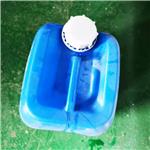- (-)-FENCHONE
-

- $0.00 / 25KG
-
2024-11-14
- CAS:7787-20-4
- Min. Order: 1KG
- Purity: 99%
- Supply Ability: 100 MT
- (-)-Fenchone
-

- $45.00 / 1mL
-
2024-11-12
- CAS:7787-20-4
- Min. Order:
- Purity:
- Supply Ability: 10g
- (-)-FENCHONE
-

- $50.00 / 1kg
-
2024-04-27
- CAS:7787-20-4
- Min. Order: 1kg
- Purity: 99.10%
- Supply Ability: 50000kg
|
| | (-)-FENCHONE Basic information |
| | (-)-FENCHONE Chemical Properties |
| Melting point | 5-6 °C(lit.) | | Boiling point | 192-194 °C(lit.) | | alpha | [α]D20 -50~-60° (c=4, C2H5OH) | | density | 0.948 g/mL at 25 °C(lit.) | | vapor pressure | 2.149hPa at 20℃ | | FEMA | 4519 | L-FENCHONE | | refractive index | n20/D 1.461(lit.) | | Fp | 127 °F | | storage temp. | 2-8°C | | solubility | Chloroform (Slightly), Ethanol (Slightly, Sonicated) | | form | Liquid | | color | Clear colorless to light yellow | | Odor | at 100.00 %. camphor herbal earthy woody | | Odor Type | camphoreous | | optical activity | [α]24/D 50.5°, neat | | Water Solubility | 1.983g/L at 20℃ | | JECFA Number | 2200 | | BRN | 2042710 | | Dielectric constant | 12.0(20℃) | | LogP | 2.54 at 20℃ | | CAS DataBase Reference | 7787-20-4(CAS DataBase Reference) | | EPA Substance Registry System | Bicyclo[2.2.1]heptan-2-one, 1,3,3-trimethyl-, (1R,4S)- (7787-20-4) |
| Risk Statements | 10 | | Safety Statements | 23-24/25 | | RIDADR | UN 1224 3/PG 3 | | WGK Germany | 3 | | RTECS | RB7875000 | | TSCA | Yes | | HazardClass | 3 | | PackingGroup | III | | HS Code | 29142900 | | toxicity | The acute oral LD50 value in rats was reported as 616 g/kg (Jenner, Hagan, Taylor. Cook & Fitzhugh, 1964) and the acute dermal LD50 value in rabbits exceeded 5 g/kg (Leven-stein, 1975). |
| | (-)-FENCHONE Usage And Synthesis |
| Chemical Properties | CLEAR COLOURLESS TO SLIGHTLY YELLOW LIQUID | | Occurrence | Reported to be found in many essential oils, including those of Thuja plicata, T.occiden-talis, T.standi shii, Russian anise, fennel, a few Artemisia varieties (A. frigida, A . verlotorum and A . santolinaefolia), Lavandula stoechas and L. burmannii. The highest levels (12-19%) are found in fennel oil (Fenarolis Handbook of Flavor Ingredients, 1975; Gildemeister & Hoffman, 1963). | | Uses | Flavoring. | | Uses | (1R,?4S)?-1,?3,?3-?Trimethylbicyclo[2.2.1]?heptan-?2-?one also known more commonly as (-)-Fenchone is a chiral intermediate of Fenchone and is currently being used for studies ranging from inhibitory effects of monoterpenes on human TRPA1 and odorant receptor of the malaria vector Anopheles gambiae. | | Preparation | By isolation from cedar leaf oil (Thuja oil) or by various synthetic methods (Arctander, 1969). | | Definition | ChEBI: A fenchone that has (1R,4S)-stereochemistry. It is a constituent of the essential oils obtained from fennel. | | General Description | (1R)-(-)-Fenchone is a bridged bicyclic ketone found in fennel oil and thuja oil. | | Flammability and Explosibility | Not classified | | Pharmacology | In mice, fenchone injected sc in sesame oil produced clonic convulsions at non-lethal
doses, with a median convulsive dose (CD50) of 1133 mg/kg, and a dose of 500 mg/kg given sc
was an effective arousal agent, reducing the hexobarbitone sleep time (Wenzel & Ross, 1957). In rats, an ip dose of 500 mg/kg had no effect on pentobarbitone-depressed respiration, while ip doses
of 50-400 mg/kg increased running activity but did not affect total activity (Wenzel & Ross, 1957).
Fenchone showed some antispasmodic action on excised mouse intestine (Haginiwa, Harada &
Morishita, 1963), and at 260 mmol/kg showed good choleretic properties of moderately long duration
when given orally in olive oil to rats (M?rsdorf, 1966). Thomas (1958) reported that it acted as
a central nervous system stimulant. Fenchone has been used medically as a counter-irritant (Merck
Index, 1968). | | Metabolism | Rimini (1901 & 1909) showed that, in the dog, fenchone was probably oxidized to 4-hydroxyfenchone. Reinartz & Zanke (1936) showed that there were other products. They separated, as lead salts, the glucuronides from the urine of dogs receiving d-fenchone. The lead was removed with sulphuric acid and the resulting solution was hydrolysed. In the resulting mixture of hydroxyfen chones, the presence of 4- and 5-hydroxyfenchones and 7r-apofenchone-3-carboxylic acid was demon strated (Williams, 1959). | | Purification Methods | Purification is as for the (+)-enantiomer above and should have the same physical properties except for opposite optical rotations. UV has max 285nm ( 12.29). [Braun & Jacob Chem Ber 66 1461 1933, UV: Ohloff et al. Chem Ber 90 106 1957.] [Beilstein 7 III 392, 7 IV 212.] |
| | (-)-FENCHONE Preparation Products And Raw materials |
| Raw materials | Anise oil-->Bicyclo[2.2.1]heptane-2-selone, 1,3,3-trimethyl-, (1R,4S)--->Bicyclo[2.2.1]heptan-2-one, 1,3,3-trimethyl-, oxime, (1R,4S)--->methyl 3-(tert-butyldimethylsilyloxy)benzoate-->(+)-Fenchol-->Methyl 3-hydroxybenzoate-->Methyl 3-methoxybenzoate |
|